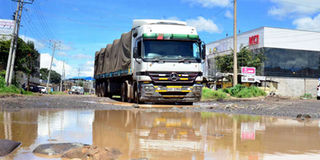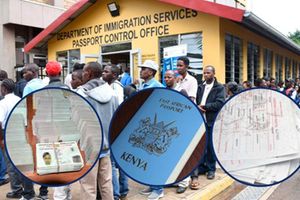Behold! The main roads to Kenya’s industrialisation

A truck manoeuvres through a badly damaged East Gate Road in Nairobi's Industrial Area on May 16, 2018. Many similar road which serve as access point to many manufacturing companies in Nairobi in a dilapidated state. PHOTO | FRANCIS NDERITU | NATION MEDIA GROUP
What you need to know:
While City Hall is supposed to manage 80 per cent of Nairobi’s roads, it has no capacity to repair and maintain them.
As a result of these troubles, the manufacturing sector has declined by 3 per cent in the past year and its contribution to GDP now stands at 8.4 per cent.
In what is supposed to be the heart of Kenya’s manufacturing sector, the dilapidated network has turned into a modern labyrinth.
The old railway network, which once carried goods from here, juts out in odd places or ends up in overgrown bush.
Nobody seems to care any more about Kenya’s Industrial Area. Some main roads are no more, while the drainage system is all gone — thanks to years of neglect.
The southern side of Mombasa Road is an eyesore, with East Gate Road — which is apparently the gateway to Kenya Ports Authority’s container depot — turned into a pool of gooey mud. Some pesky pigs find solace here, wallowing in dirty puddles.
When the private sector met President Kenyatta on May 10 at State House, the state of the roads in industrial area was placed under “inefficient logistics” and cited as one of the main hindrances to growth of the sector.
OVERGROWN BUSH
The other hindrances are high energy costs, import declaration fee, railway development levy, taxes on raw materials, delayed payments and low access to affordable credit.
While City Hall is supposed to manage 80 per cent of Nairobi’s roads, it has no capacity to repair and maintain them.
As a result of these troubles, the manufacturing sector has declined by 3 per cent in the past year and its contribution to GDP now stands at 8.4 per cent.
“We are engaging the government to find a solution to our problems. Some factories built over 30 years ago still have no proper infrastructure,” said Mr Manoj Shah, an investor in the area.
In what is supposed to be the heart of Kenya’s manufacturing sector, the dilapidated network has turned into a modern labyrinth. The old railway network, which once carried goods from here, juts out in odd places or ends up in overgrown bush.
MASTER PLAN
Most of the colonial-era railway sidings, built to transport goods to Industrial Area, have been uprooted and the paths grabbed.
For decades, the roads in Industrial Area were left to the moribund Nairobi City Council — now county government of Nairobi— which neglected the infrastructure as it struggled with unending cash crises and graft. Calls had been made as early as 1980 by then Lang’ata MP Phillip Leakey to place this road network under the central government.
Recently, Transport Cabinet Secretary James Macharia told the Nation: “We have met with the stakeholders and decided to take over and repair these roads”. He added that three locations had been identified as “most critical” and a total of Sh4.2 billion would be used to rebuilt these roads.
“The national government will contribute Sh2.6 billion while the county government will foot the balance,” said Mr Macharia.
Part of the problem is the development of an industrial area in a city that has no valid master plan.
SEGREGATION
The original 1948 Nairobi Master Plan for a Colonial Capital first overestimated the role of the railways in transportation of goods to and from the industries — and did little to address the issue of road network.
While the master plan created guidelines for the next 20 years — up to 1968 — which earmarked land for residential and industrial use, and is responsible for the current layout of Industrial Area — it was much more concerned with racial segregation than with the future of a city.
The wide boulevards envisioned by South African planners in 1948 are still in place, though overgrown with thickets and muddy walkways. Even where roads exist, the sidewalks are an indicator of what has gone wrong with our quest to become an middle-income nation.
KURA
While the 1948 master plan proposed the relocation of the railway line from inside the city — it used to pass outside Norfolk Hotel — and the dual Uhuru Highway with the aim of making Nairobi look more spacious and attractive for industrial investment, the Nation found an infrastructure crying for attention.
While the master plan helped sort out the road system of Nairobi, by firming up the Railway’s decision to relocate “the loop”.
The sprawling industrial complex was designed to be conveniently near the railway and the assumption was that a railway network would serve these industries.
Seventy years after the master plan laid out the Industrial Area concept, the current struggles are on who should take charge of the roads. That the industrialists have been tossed from City Hall to the Kenya Urban Roads Authority (Kura) is clear from their minutes.
THREE YEARS
“It is not clear who owns the roads... it was reported that they are under the county government, which doesn’t have the capacity to improve them,” reads minutes of 15 industrialists who occupy the Masai Road/East Gate triangle.
For the past eight years, road works on Likoni Road/Enterprise Road have been ongoing, with no end in sight.
The Nation found workers from Raynolds Construction Company (RCC) still on sight at a bridge which has been under construction for more than three years now.
“That road has taken forever to construct and we are now tired of waiting,” an industrialist who sought anonymity said.
From Lunga Lunga Road to the Donholm side, the dilapidated infrastructure tells the story of an industrial complex facing ruin.





